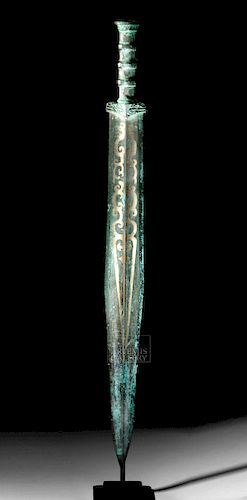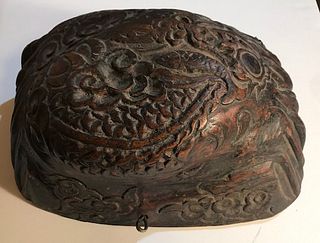Chinese Zhou Dynasty Tinned Bronze / Tin Short Sword
Lot 110d
About Seller
Artemis Gallery
686 S Taylor Ave, Ste 106
Louisville, CO 80027
United States
Selling antiquities, ancient and ethnographic art online since 1993, Artemis Gallery specializes in Classical Antiquities (Egyptian, Greek, Roman, Near Eastern), Asian, Pre-Columbian, African / Tribal / Oceanographic art. Our extensive inventory includes pottery, stone, metal, wood, glass and textil...Read more
Categories
Estimate:
$15,000 - $20,000
Absentee vs Live bid
Two ways to bid:
- Leave a max absentee bid and the platform will bid on your behalf up to your maximum bid during the live auction.
- Bid live during the auction and your bids will be submitted real-time to the auctioneer.
Bid Increments
| Price | Bid Increment |
|---|---|
| $0 | $25 |
| $300 | $50 |
| $1,000 | $100 |
| $2,000 | $250 |
| $5,000 | $500 |
| $10,000 | $1,000 |
| $20,000 | $2,500 |
| $50,000 | $5,000 |
| $100,000 | $10,000 |
| $200,000 | $20,000 |
About Auction
By Artemis Gallery
Feb 21, 2019
Set Reminder
2019-02-21 10:00:00
2019-02-21 10:00:00
America/New_York
Bidsquare
Bidsquare : Exceptional Antiquities, Asian, Ethnographic
https://www.bidsquare.com/auctions/artemis-gallery/exceptional-antiquities-asian-ethnographic-3858
An important one-day auction featuring museum-worthy examples of Egyptian, Greek, Roman, Etruscan, Near Eastern, Far East / Asian, Pre-Columbian, African / Tribal, Oceanic, Native American, Spanish Colonial, Russian, Fossils, Ancient Jewelry, Fine Art, so much more! Artemis Gallery info@artemisgallery.com
An important one-day auction featuring museum-worthy examples of Egyptian, Greek, Roman, Etruscan, Near Eastern, Far East / Asian, Pre-Columbian, African / Tribal, Oceanic, Native American, Spanish Colonial, Russian, Fossils, Ancient Jewelry, Fine Art, so much more! Artemis Gallery info@artemisgallery.com
- Lot Description
East Asia, China, Eastern Zhou Dynasty, Warring States period, ca. 4th to 3rd century BCE. A stunning cast-bronze short sword (known as a duan jian) formed via the lost wax (cire perdue) method. The elegant blade widens gradually towards the midsection and then tapers to a sharp point, with angled bevels forming both blade edges, and a prominent central rib creating deep facial grooves. A diamond-shaped guard with a central rib follows that of the blade and forms the nasal bridge of a stylized anthropomorphic mask evocative of the Shang Dynasty. A hollow cylindrical handle boasts a trio of raised ringlets as well as a tiered pommel decorated with concentric pattern-molded triangular and rectangular motifs; a hollow cavity within would have held a decorative pommel cap. Mirrored waves of tinned bronze are inlaid on both faces in an abstract dragon style with a roaring mouth, serpentine bodies, and tails which taper and meet near the bottom. Custom museum-quality display stand included. Size: 1.9" W x 22.5" H (4.8 cm x 57.2 cm); 23.75" H (60.3 cm) on included custom stand.
This sword represents a fascinating period in the history of sword making. Iron swords are known from China over 1000 years before one was made, but they were made of iron ore from meteorites and were purely ceremonial because of their being made of incredibly rare material and being brittle. The Warring States period saw a transition in military styles, from bronze weaponry and chariot-based fighting to iron and cavalry. However, the old period was still revered. Despite the cost of manufacturing bronze swords like this on a mass scale, this particular style of duan jian – a double-edged straight sword – was used in China for approximately 2,500 years. Finely made bronze weapons such as this one were signs of prestige, wealth, and fighting prowess used in both ceremonial and funerary contexts. For example, swords were worn by the Emperor and his officials in ceremonial or official dress, attached to the belt with jade ornaments.
For a stylistically-similar example, please see The Metropolitan Museum of Art, accession number 1992.298.2: https://www.metmuseum.org/art/collection/search/44717
For another stylistically-similar example with a gilded blade, please see the Saint Louis Art Museum, object number 41:2014: https://www.slam.org/collection/objects/43982/
A very similar example with no inlays hammered for $23,750 at Christie's, New York "Fine Chinese Ceramics and Works of Art" auction (sale 2689, March 21-22, 2013, lot 1229): https://www.christies.com/lotfinder/lot/a-rare-gold-inlaid-bronze-sword-early-warring-5661957-details.aspx?from=searchresults&intObjectID=5661957&sid=20181776-fa95-4278-ba3a-55e7b24d7a37
Finally, a stylistically-similar example with inlaid-gold Chinese characters hammered for $183,750 at Christie's, New York "Fine Chinese Ceramics and Works of Art" auction (sale 2689, March 21-22, 2013, lot 1234): https://www.christies.com/lotfinder/lot/a-very-rare-and-important-gold-inlaid-bronze-5661962-details.aspx?from=searchresults&intObjectID=5661962&sid=20181776-fa95-4278-ba3a-55e7b24d7a37
Provenance: private East Coast, USA collection; ex-private New York, New York, USA collection, acquired in the 1990s
All items legal to buy/sell under U.S. Statute covering cultural patrimony Code 2600, CHAPTER 14, and are guaranteed to be as described or your money back.
A Certificate of Authenticity will accompany all winning bids.
We ship worldwide and handle all shipping in-house for your convenience.
#143844Professionally cleaned with patina removal in several areas and polishing to most of blade. Original pommel cap missing. Minor abrasions to handle, pommel, and blade, with light encrustations in some recessed areas, and very minor nicks to blade edges, otherwise intact and near-choice. Light earthen deposits and fabulous malachite green patina throughout.Condition
- Shipping Info
-
All shipping is handled in-house for your convenience. Your invoice from Artemis Gallery will include shipping calculation instructions. If in doubt, please inquire BEFORE bidding for estimated shipping costs for individual items.
-
- Buyer's Premium



 EUR
EUR CAD
CAD AUD
AUD GBP
GBP MXN
MXN HKD
HKD CNY
CNY MYR
MYR SEK
SEK SGD
SGD CHF
CHF THB
THB
















